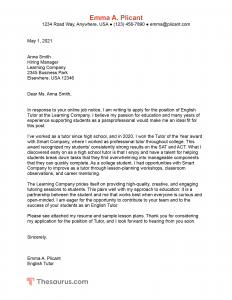You’re a shining star in your field, and you’ve found the perfect job listing. How do you make a great first impression with the company you’d like to work for? Well, let’s address the basics first: there’s one person you’ve got to impress right away. That’s right—whether that person is a hiring manager or your future supervisor—you’re got to impress that first person who reviews your cover letter and forms an impression of you as an applicant.
So how do you start that letter the right way and get their attention? This article (Steps 2–4) in our comprehensive cover letter series will help you format and write the key elements of an introduction to your cover letter. You’ll move on to steps 5–7 to write the rest of the letter.
Step 1. Format Your Cover Letter
✅ Step 2–4. Open The Cover Letter With A Proper Header, Greeting, And Memorable Introduction
Step 5–7. Explain You’re Fit For The Job, Add A Call To Action, And End With The Right Sign-off
Step 8–9. Edit And Share Your Cover Letter
We’ve provided a sample cover letter you can use to follow along in this series and create your own. Click on the image below to expand it.
2. Start the cover letter with a header
What to include in the header
The first part of your cover letter is the header. Traditionally, a header would be formatted similarly to the heading of any formal letter. These days, it is more common to find a header that is the same or similar to the section that lists the name and contact details on your resume. Whether you use a traditional heading or a more contemporary header will depend on the job to which you are applying. Either way, your header should include:
- Your name
- Your contact details
- Your job title (if applicable)
- The name of the hiring manager
- The contact details of the hiring manager
- The date
Examples of headers
Here is the traditional format for the header of a cover letter. We will cover alternatives to this traditional format in a little bit.
May 1, 2021
Emma A. Plicant
English Tutor
1234 Road Way
Anywhere, USA 12345
(123) 456-7890
emma@plicant.com
May 1, 2021
Anna Smith
Hiring Manager
Tutoring Company
2345 Business Park
Elsewhere, USA 12346
Step 3. Include a proper greeting
A cover letter is a kind of formal letter, meaning it needs to include a greeting similar to that of any other kind of letter or email. This greeting should begin “Dear” or “To” and end with a comma, not a period.
Who should you address your cover letter to?
Ideally, you will address your cover letter directly to the hiring manager. If the name of the hiring manager is not listed on the job posting, you will need to do a little digging to try and find it. A good place to start is the website for the company itself. (Try to find a link like “About Our Staff.”) Even if you don’t find the name of the hiring manager there, you will be able to learn more about the company’s mission, values, and practices from the website. Some workplaces even go so far as to state specifically what they are looking for in a cover letter on their website.
Other sources for the name of the hiring manager include websites like LinkedIn and Glassdoor.
Note that the job title of the person in charge of hiring for the position may not be Hiring Manager. They may have a different kind of title altogether, like Administrative Assistant or Recruiter.
If you’re unable to find the name of the hiring manager to include on the cover letter, you can simply write Hiring Manager in the header or leave the spot blank.
The question of how to properly address your cover letter also comes up when it comes to writing the greeting.
Examples of greetings
A typical greeting for a cover letter if you know the name of the hiring manager is:
Dear [Mr./Ms.] [Last Name of Hiring Manager]
example: Dear Ms. Smith,
Other, more contemporary greeting forms are:
Dear [Full Name] example: Dear Anna Smith,
[Full Name]
example: Anna Smith,
If you are unable to find the name of the hiring manager, you have a few options when it comes to addressing your cover letter:
Dear Hiring Manager,
Dear [Company] Team,
To Whom It May Concern,
Dear Sir or Madam,
Addressing a cover letter with “To Whom It May Concern” or “Dear Sir or Madam” is somewhat controversial. Some counsel against it, others find that employers prefer it. If you feel uncertain about using either of these greetings, stick with the traditional “Dear Hiring Manager.”
Looking for even more options for “to whom it may concern”? Review some of them here.
Step 4. Write a memorable introduction
It can be hard to know how to start a cover letter, but once you know the formula, it is fairly straight-forward. Your introductory paragraph should be one to three sentences long and include the following information:
- The name of the position you are applying for
- A brief description of your experience
- A sense of why you are interested in the position
Of all of these things, it is most important to state the name of the position—you would be amazed how many people leave this critical piece of information out.
Examples of strong introductions
Here are a couple of examples of a strong introduction for a cover letter:
- In response to your online job notice, I am writing to apply for the position of English Tutor at Learning Company. I believe my passion for education and many years of experience supporting students as a paraprofessional would make me an ideal fit for this post.
- As a longtime supporter of animal welfare causes, I am thrilled to have the opportunity to apply for the position of Fundraiser for Animal Welfare Nonprofit. I have over five years of experience in the nonprofit fundraising sector, raising over $200,000 annually, and I think these skills and my dedication to the issues would be an asset to your organization.
Be sure to double-check that you have correctly transcribed the job title and the name of the company!














